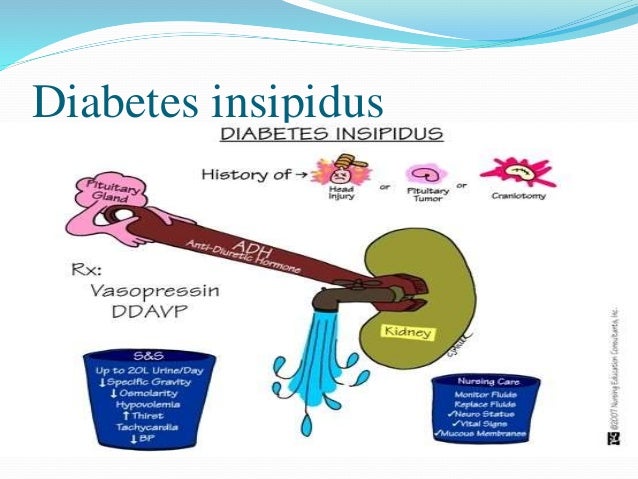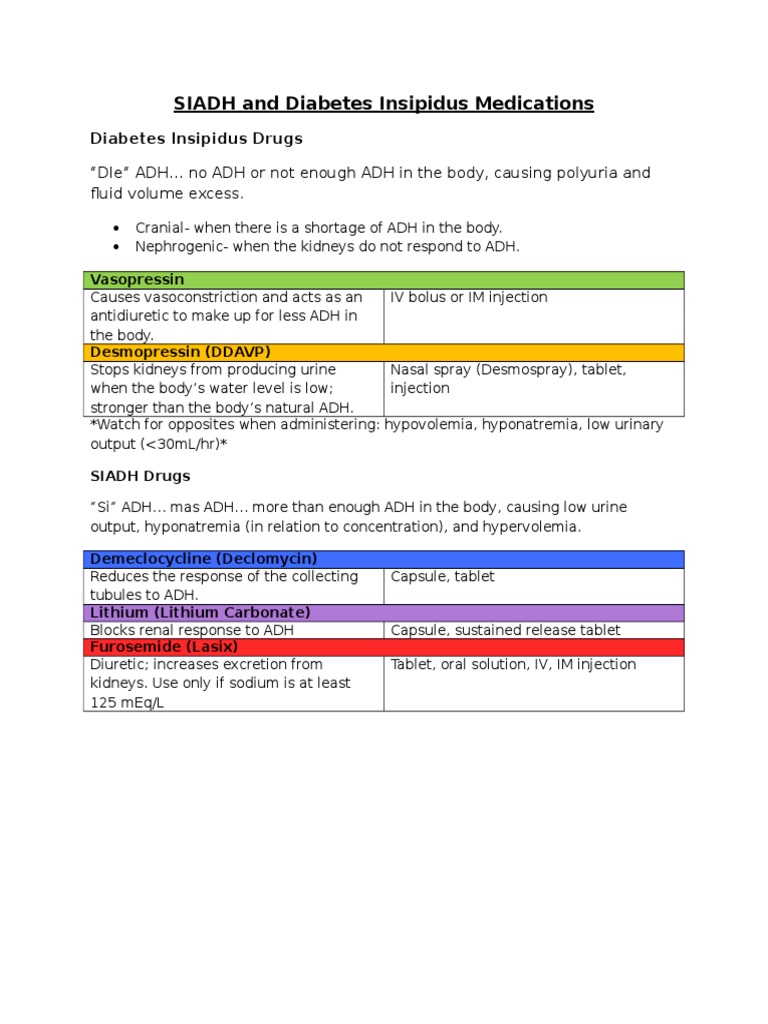Diabetes Insipidus Hyponatremia
In this webinar professor mirjam christ-crain (switzerland) will discuss the topic of hyponatremia/ diabetes insipidus in the time of covid-19. the key learning points of this talk include: challenges in the evaluation and management of patients with central diabetes insipidus in the outpatient setting in times of covid-19. One of the most common effects of diabetes insipidus on the human body is the development of hypernatremia. this is a medical term that is used to describe the presence of elevated sodium levels within the blood because of an electrolyte imbalance. hypernatremia is defined by having sodium serum levels measured at 145 meq/l or The major symptoms of central diabetes insipidus (di) are polyuria, nocturia, and polydipsia due to the concentrating defect. treatment of this disorder is primarily aimed at decreasing the urine output, usually by increasing the activity of antidiuretic hormone (adh; also called arginine vasopressin or avp).
Diabetesinsipidus (die-uh-bee-teze in-sip-uh-dus) is an uncommon disorder that causes an imbalance of fluids in the body. this imbalance makes you very thirsty even if you've had something to drink. it also leads you to produce large amounts of urine. while the terms "diabetes insipidus" and "diabetes mellitus" sound similar, they're not related. Diabetes insipidus hyponatremia occurs when the sodium levels within the body reach very low levels. this electrolyte is needed by the body to control water levels and when it is at levels which are abnormally low, the body’s cells begin to swell up. the end result is a problem that can become life threatening if treatment is received for the diabetes insipidus so that electrolyte levels can balance themselves out. For patients with diabetes insipidus who have hyponatremia, the syndrome of inappropriate secretion of antidiuretic hormone (siadh) and cerebral salt-wasting syndrome should be considered. with siadh, the unregulated release and subsequent activity of vasopressin leads to hyponatremia caused by excess fluid retention.
Clinical Aspects Of Diabetes Insipidus And Hyponatremia

Diabetesinsipidus and syndrome of inappropriate anti-diuretic hormone [siadh] have some similarities, but are two very different conditions. they both involve how the body create vasopressin [adh] and one of the primary symptoms of both conditions is excessive thirst, but the results are completely the opposite. in diabetes insipidus, the body is excreting too many

Antidiuretic hormone (adh) is released from the posterior pituitary for a number of physiologic reasons. the majority of people with hyponatremia, other than those with excessive water intake (polydipsia) or renal salt wasting, will have elevated adh as the cause of their hyponatremia. In addition to the symptoms of diabetes insipidus, people who have hypernatremia may experience a feeling of weakness in their muscles, irritability, fever, and general restlessness. in some instances, migraine headaches may be triggered, seizures may occur, and there may be severe changes to an individual’s blood sugar levels. In this article, i am going to easily break down the differences between diabetes insipidus (di) and siadh (syndrome of inappropriate anti-diuretic hormone). i addition, i provide a lecture on how to remember the differences between the two! don’t forget to take the siadh vs diabetes insipidus quiz.
Postoperative Diabetes Insipidus And Hyponatremia In
Central diabetes insipidus can occur in the setting of primary or metastatic tumors that disrupt the hypothalamic-pituitary axis. usual treatment consists of water intake to replace ongoing fluid losses and desmopressin administration aimed at decreasing the urine output to enable maintenance of eunatremia without polyuria. Diabetes insipidus (die-uh-bee-teze in-sip-uh-dus) is an uncommon disorder that causes an imbalance of fluids in the body. this imbalance makes you very thirsty even if you've had something to drink. it also leads you to produce large amounts of urine. while the terms "diabetes insipidus" and "diabetes mellitus" sound similar, they're not related. Hyponatremia and hypernatremia are classified based on volume status (hypovolemia, euvolemia, and hypervolemia). water loss can be pure water loss (e. g. in diabetes insipidus) or hypotonic. Hyponatremia/ diabetesinsipidus thursday 11 june, 16:00 cet in this webinar professor mirjam christ-crain (switzerland) will discuss the topic of hyponatremia/ diabetes insipidus in the time of covid-19. the key learning points of this talk include:.
In diabetes insipidus, urine concentrations are never high. it creates a very dilute urine that can be in high amounts. some patients with diabetes insipidus can pass up to 6 gallons of urine per day. you’ll see lower blood pressure, high sodium levels, and the signs and symptoms of dehydration present. More diabetes diabetes insipidus hyponatremia insipidus hyponatremia images. Diabetesinsipidus. in diabetesinsipidus, or di, the body produces too little anti-diuretic hormone. since diuresis means the production of urine, a shortage of adh, which works against diuresis.
Clinical aspects of diabetes insipidus and hyponatremia gary robertson. author affiliations. northwestern university, chicago, illionois, usa. diabetes insipidus (di) is a syndrome caused by various defects in the secretion or action of the antidiuretic hormone, arginine vasopressin (avp). they include impaired avp production (pituitary di. Diabetes insipidus (di) is a syndrome caused by various defects in the secretion or action of the antidiuretic hormone, arginine vasopressin (avp). Okay, the way to differentiate central and nephrogenic diabetes insipidus is to look at the adh level; with central diabetes insipidus, there’s low adh, while with nephrogenic diabetes insipidus, adh is normal or high. remember this as it’s a very high yield concept. in addition, a water deprivation test can be done. Hyponatremia that results from avp production in the absence of an osmotic or hemodynamic stimulus is termed syndrome of inappropriate antidiuretic hormone secretion (siadh). the goals of this chapter are to review both diabetes insipidus and siadh, their causes and their treatment. 19. 2. diabetes insipidus and siadh 19. 2. 1.
Diabetesinsipidus is a rare disorder that occurs when a person's kidneys pass an abnormally large volume of urine that is insipid—dilute and odorless. in most people, the kidneys pass about 1 to 2 quarts of urine a day. in people with diabetes insipidus, the kidneys can pass 3 to 20 quarts of urine a day. See more videos for diabetes insipidus hyponatremia. Most cases of acquired central diabetes insipidus are caused by destruction of the neurohypophysis by: 1) anatomic lesions that destroy the vasopressin neurons by pressure or diabetes insipidus hyponatremia infiltration, 2) damage to the vasopressin neurons by surgery or head trauma, and 3) autoimmune destruction of the vasopressin neurons.
Diabetesinsipidus is a condition where the body loses too much fluid through urination, causing a significant risk of dangerous dehydration as well as a range of other illnesses and conditions. What is diabetes insipidus (di) and siadh. both diabetes insipidus (di) and syndrome of inappropriate antidiuretic hormone secretion (siadh) are both disorders of water regulation impacting the diabetes insipidus hyponatremia release or activity of anti-diuretic hormone (adh) in the body. in siadh, antidiuretic hormone is not suppressed causing significant electrolyte abnormalities and water retention.
Hyponatremia Diabetes Insipidus Ese
Di: diabetes insipidus, siadh: syndrome of inappropriate antidiuretic hormone secretion, tss: transsphenoidal surgery. **p<0. 01, *p<0. 05 the day when patients developed di was defined as the day when patients received the first dose of desmopressin or the first day of symptoms in patients that did not require desmopressin ( figure 2 ; available. Differentiating between hypernatremia (central neurogenic diabetes insipidus) and the 2 hyponatremia syndromes (syndrome of inappropriate secretion diabetes insipidus hyponatremia of antidiuretic hormone, and cerebral salt-wasting syndrome) is critical for preventing worsening neurological outcomes in patients with head injuries.


Comments
Post a Comment